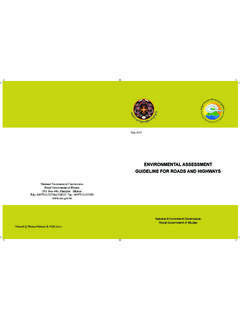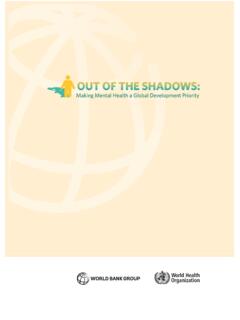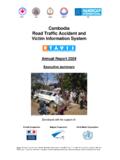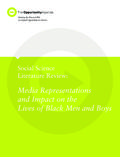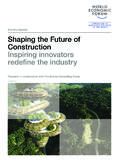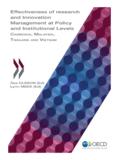Transcription of Bhutan State of Environment, 2016 - nec.gov.bt
1 Bhutan State of the environment report 2016 National environment CommissionRoyal Government of Bhutan2016 Bhutan State of the environment report 2016 Coordinated and Edited by: Chencho Norbu, Secretary, NECS Karma C. Nyedrup, environment Specialist, NECS Thinley Namgyel, Chief, CCD, NECS Tshewang Dorji, Dy. CEO, CCD, NECS Tshering Tashi, Communication Officer, NECS Sonam Dagay, Asst. environment Officer, CCD, NECS BSER 2016 Drafting Team and Contributing Authors: Karma C. Nyedrup, environment Specialist, NEC Thinley Namgyel, Chief, CCD, NECS Jigme Nidup, Dy. CEO, WRCD, NECS Tshewang Dorji, Dy. CEO, CCD, NECS Sonam L. Khandu, Dy. CEO, CCD, NECS Karma Tshering, Sr. Program Officer, PPS, NECS Sonam Choden, Sr. Forestry Officer, WMD, DOFPS Jigme Dorji, Sr.
2 Biodiversity Officer, NBC, MoAF Tshering Tashi, Communication Officer, NECS Sonam Dagay, Asst. environment Officer, CCD, NECS Karma Yangzom, Asst. Land Record Officer, NLC Rinzin Namgay, ICT, NECS Design and Layout: Tshering Tashi, Communication Officer, NECS Published by: National environment Commission Royal Government of Bhutan Post Box # 466 Thimphu, Bhutan Tel: +975 2 323384/324325 Fax: +975 2- 323385 ISBN # 978-99936-865-5-2 National environment Commission, 2016 Contents Preface .. 1 Foreword .. 2 Executive Summary .. 3 to the National environment report .. Introduction .. 6 State of the environment reporting .. 6 Process .. 7 Methodology .. 7 features .. Geography .. 8 Climate .. 8 and socio-economic development.
3 Demography .. 8 Poverty .. 8 Socioe-conomic development ..9 Industries .. 9 Energy .. 10 Urbanization .. 10 Migration .. 11 Tourism .. 12 Transport .. 12 Health services and infrastructure .. 12 .. Pressure .. 13 State .. 22 Impact .. 28 Response .. 30 Recommendations .. 30 .. Pressure .. 32 State .. 33 Impact .. 36 Response .. 37 Recommendations .. 38 .. Pressure .. 39 State .. 43 Impact .. 46 Response .. 46 Recommendations .. 47 .. Pressure .. 49 State .. 50 Impact .. 53 Response .. 55 Recommendations .. 57 oss-cutting issues: Waste Management .. Pressure .. 58 State .. 58 Impact .. 60 Response .. 61 Recommendations .. 61 issues: Climate .. Pressure .. 63 State .. 63 Impact.
4 63 Response .. 65 Recommendations .. 67 of Recommendations in Bhutan environment Outlook 2008 .. Land .. I Water .. VI Air .. IX Biodiversity .. XIII General Recommendations .. XV Annexure I: DPSIR Framework .. I Annexure II: Policy Responses .. IV Annexure III: Recommendation of Waste Management Conference .. VII Annexure IV: Waste Management in Thimphu City .. VIII Annexure V: Ecological footprint of Bhutan report 2014 .. IX 1 Acronyms and Glossary of Bhutanese Terms .. 4 Preface The Bhutan State of the environment report 2016 is the third edition of the periodic reports on Bhutan s State of the environment (SOE). The National environment Commission and its Secretariat are mandated to publish periodic SOE reports to provide environmental information to the citizens of Bhutan .
5 The SOE report provides information on the current State and trends in Bhutan s environment , the underlying causes of environmental change and the responses to such changes. This Bhutan State of the environment report has been prepared by the National environment Commission Secretariat with support from relevant stakeholders, through a consultative and review process. The report covers four thematic areas of land, water, air and biodiversity, while waste management and climate change has been considered as cross cutting issues. Each of these themes are described using the framework of drivers, pressures, State , impact and response (DPSIR) and is based on published information and data collected from various organizations. The information in the SOE report aims to improve the understanding of environment and sustainable development issues and for informed decision-making.
6 As a result, this report supports the government and citizens in their respective constitutional responsibilities in environmental conservation while pursuing justifiable socio-economic development and ultimately for the wellbeing of the Bhutanese people. Chencho Norbu Secretary Foreword Conservation of environment has always played a central role in Bhutan s approach to economic development. Concern for our natural environment and heritage is embedded in the development philosophy of Gross National Happiness guided by the enlightened and visionary leadership of our beloved Monarchs. The health of our environment has a direct link and bearing on the quality of life and economy for present and future generations. The natural environment provides many essential ecosystem services that we take for granted, such as clean air & water, and natural resources required for sustainable development.
7 It is because of this critical role of our natural environment and the fragile mountainous situation of our country, that under the Article 5 of the Constitution of Bhutan , environmental stewardship is the duty of every Bhutanese and also a mandate for the government. With the continuing rapid pace of socio-economic development, there are emerging challenges for our environmental obligations in the government s constitutional mandate to secure ecologically balanced sustainable development, while promoting justifiable economic and social development . Periodic reporting on the State of the environment informs our citizens and also helps the government in this mandate by identifying emerging issues and recommending effective actions.
8 Bhutan s first State of the environment report was prepared in 2001, followed by the second edition in 2008. The third edition of the State of the environment is timely and will inform citizens on the present State of the environment and also help planners to integrate environmental concerns in developing the 12th Five Year Plan. I urge all relevant stakeholders, government and non-government, civil society organizations, academia, private sector and citizens to actively take part in the implementation of recommendations highlighted in this report for the benefit of present and future generations. Lyonpo Yeshey Dorji Vice Chair of NEC and Minister for Agriculture and Forests Executive Summary The country today has of total land area under forest cover and more than half of the country s landscape ( ) is under protected areas.
9 Nonetheless, the State of Bhutan s environment has been changing over time due to population growth and economic development. The pressures on environment are directly proportional to the number of people dependent on natural resources. Bhutan s population is estimated to be 757,042 in 2015. Economic developments also exert pressure on the environment . According to the International Monetary Fund, Bhutan was recognized as the 4th fastest growing economy in the world in 2012. The country s Gross Domestic Product per capita has been increasing. Bhutan s GDP per capita in 2014 was USD 2, Land: The conversion of arable land and forests into other land uses is increasing at an alarming rate. The pressure is mostly from accelerated construction of farm roads, electricity transmission/distribution lines, industries and urbanization.
10 There are also emerging signs of forest degradations within the % forest cover area. Forest management units (FMUs) are areas designated for scientifically managed timber production. Some report suggest FMUs are being overharvested. More alarmingly, supply of timber and fuel wood are much higher from forests falling outside of FMUs, indicating that there is overall, very high pressure on the forests and its resources. Pressures in critical watersheds and water sources are also likely to impact water supply. These impacts are compounded by rapid and poor road construction methods that are not only triggering numerous surface runoffs and landslides in geologically fragile areas but are also opening previously inaccessible forest areas and watersheds to exploitation.
